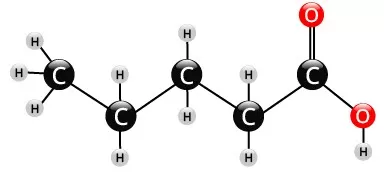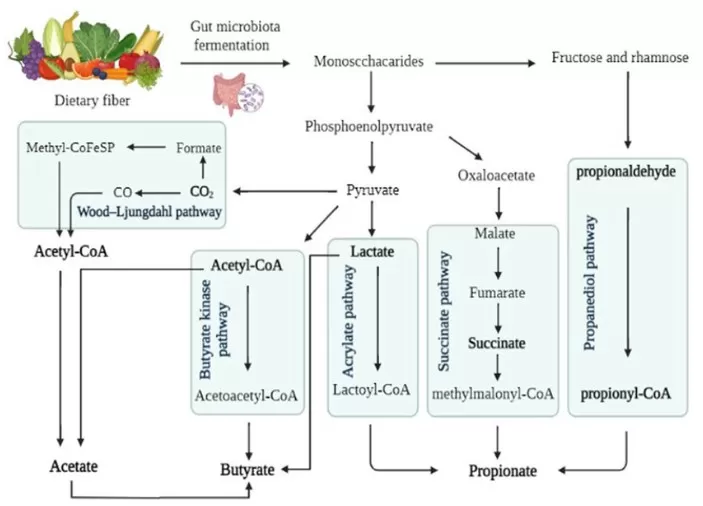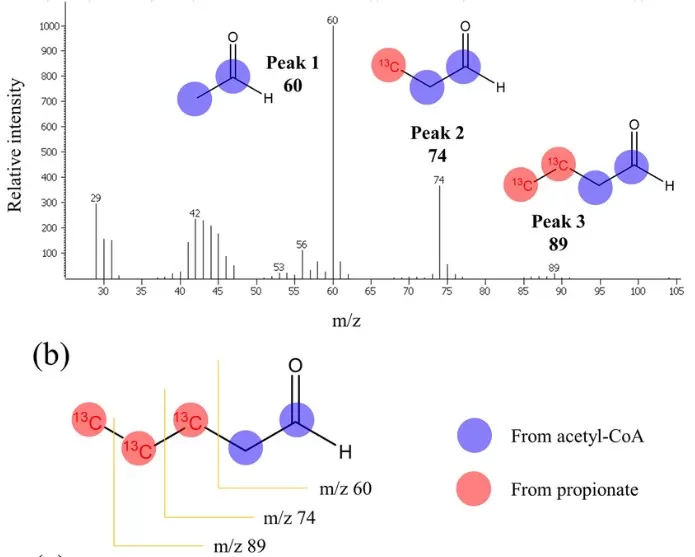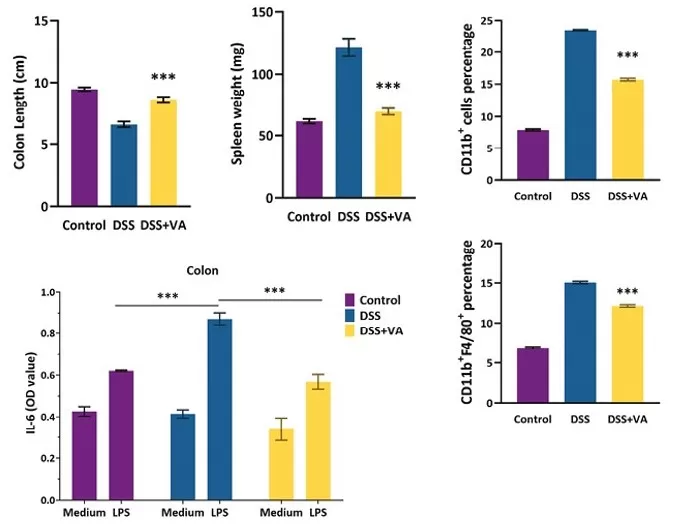Valeric Acid: A Small Molecule with Big Impacts on Human Health
Valeric acid (pentanoic acid) is a five-carbon short-chain fatty acid (SCFA) increasingly recognized for its multifaceted roles in human health and disease. Initially identified in valerian root, valeric acid is now known to be a microbial metabolite, a pharmaceutical intermediate, and a signaling molecule linking gut microbes to systemic physiology. In this blog, we will explore its discovery, chemical structure, biosynthesis, metabolic fate, and evidence-based roles in human disease. We will also touch on its functions in plants and its real-world applications in health, food, and biotech industries.
Discovery and Structure of Valeric Acid
 Valeric acid was first isolated in the mid-19th century from the root of Valeriana officinalis, a plant historically used as a sedative. The name "valeric" is derived from this botanical origin. Chemically, valeric acid is a straight-chain saturated monocarboxylic acid with the formula C5H10O2. Its structure consists of a four-carbon alkyl chain attached to a terminal carboxyl group (CH3-(CH2)3-COOH). Valeric acid is a colorless oily liquid with a pungent odor, but its esters, such as ethyl valerate and pentyl valerate, have fruity aromas and are used in flavoring.
Valeric acid was first isolated in the mid-19th century from the root of Valeriana officinalis, a plant historically used as a sedative. The name "valeric" is derived from this botanical origin. Chemically, valeric acid is a straight-chain saturated monocarboxylic acid with the formula C5H10O2. Its structure consists of a four-carbon alkyl chain attached to a terminal carboxyl group (CH3-(CH2)3-COOH). Valeric acid is a colorless oily liquid with a pungent odor, but its esters, such as ethyl valerate and pentyl valerate, have fruity aromas and are used in flavoring.
Microbial Biosynthesis Pathway of Valeric Acid
Valeric acid is mainly produced by anaerobic gut bacteria through a chain elongation process. One key route involves the condensation of ethanol and propionate. Ethanol is first oxidized to acetyl-CoA, while propionate is activated to propionyl-CoA. These two CoA derivatives undergo thiolase-mediated condensation to form 3-ketopentanoyl-CoA, which is then reduced and converted to valeric acid via CoA-thioester intermediates. This pathway shares similarities with butyrate synthesis and reflects metabolic plasticity based on substrate availability. Notably, the balance of ethanol and propionate in the gut influences whether microbes produce butyrate (C4) or valerate (C5).

Valeric Acid Biosynthesis Pathway (Kim et al., 2019)
Valeric Acid Metabolism & Systemic Circulation
Valeric acid produced in the colon is absorbed as its ionized form (valerate) and transported via the portal vein to the liver. Hepatocytes can metabolize it through beta-oxidation to acetyl-CoA and propionyl-CoA, entering the TCA cycle or gluconeogenesis. Apart from energy metabolism, valeric acid acts as a signaling molecule. It binds to free fatty acid receptors (GPR41/FFAR3 and GPR43/FFAR2), modulating insulin sensitivity, inflammation, and satiety. It also inhibits histone deacetylases (HDACs), affecting gene expression through epigenetic mechanisms, akin to butyrate.

Mass Spectrum of Valeric Acid (Zhu et al., 2021)
Valeric Acid in Neurodegenerative Diseases: Anti-inflammatory and Neuroprotective Effects
Recent studies highlight valeric acid's neuroprotective potential, especially in Parkinson's disease (PD). In PD models, valeric acid preserves dopaminergic neurons by reducing oxidative stress and suppressing neuroinflammation. It downregulates pro-inflammatory cytokines (TNF-α, IL-1β), mitigates α-synuclein aggregation, and inhibits microglial activation. In Alzheimer's disease (AD), valeric acid and other SCFAs inhibit beta-amyloid aggregation and are found at reduced levels in patients with cognitive decline. These findings suggest valeric acid as a candidate for adjunctive neurodegenerative therapy.
Valeric Acid in Gut Inflammation and Immune Modulation
Valeric acid plays a protective role in gut inflammation. In ulcerative colitis (UC) mouse models, valeric acid supplementation increased GPR41 and GPR43 expression on immune cells, dampened macrophage activation, and lowered IL-6 levels. It also restored intestinal barrier integrity and microbial diversity. In radiation-induced enteritis, valeric acid improved survival rates, protected thymic and intestinal structures, and normalized gut flora. These effects support its utility in inflammatory bowel disease (IBD) and intestinal injury mitigation.

Valeric acid alleviates inflammation in ulcerative colitis model (Liu et al., 2024)
Valeric Acid in Metabolic Syndrome and Cardiovascular Health
Valeric acid has systemic metabolic effects. It enhances GLP-1 secretion, improves insulin sensitivity, and reduces inflammatory cytokines—key factors in obesity and type 2 diabetes. In animal studies, gut-derived valeric acid reached ocular tissues and reduced intraocular pressure, suggesting endocrine-like functions. It also modulates sympathetic nerve activity and may reduce blood pressure. Thus, valeric acid represents a potential metabolic regulator bridging gut microbiota and host physiology.
Valeric Acid in Cancer Prevention and Epigenetic Regulation
As an HDAC inhibitor, valeric acid modulates chromatin structure and gene expression, influencing tumor suppressor and apoptotic gene activity. In breast cancer cell lines, valeric acid induces growth arrest and apoptosis, possibly through enhanced histone acetylation. Its anti-inflammatory effects may also alter the tumor microenvironment. While clinical data are still limited, these mechanisms highlight valeric acid’s potential in cancer prevention or as a therapeutic adjunct.
Valeric Acid’s Role in Radiation Injury Protection
Valeric acid has demonstrated protective effects in models of radiation-induced injury. In irradiated mice, valeric acid administration led to improved survival and preservation of thymus and spleen integrity. Moreover, it helped maintain gastrointestinal tract structure and restored microbial balance. These findings suggest potential application in mitigating side effects of radiotherapy or accidental exposure.
Intraocular Pressure & Eye Health Effects of Valeric Acid
In experimental studies, valeric acid administered rectally was detected in ocular tissues and significantly reduced intraocular pressure. This effect was independent of blood pressure or known SCFA receptors, pointing to a novel mechanism of action. Valeric acid could therefore be a lead compound for future development in glaucoma management.
Plant Physiology & Defense: Valeric Acid's Role
In plants, valeric acid and related compounds contribute to postharvest quality and defense. For example, in plum fruits, external application of valeric acid preserves firmness by inhibiting cell wall-degrading enzymes (PG, PL, PE) and enhancing lignification pathways. Valeric acid also functions as a volatile compound released by soil microbes, influencing plant root architecture and signaling. Moreover, its pungent odor serves as a natural insect repellent, supporting plant defense.
Valeric Acid Applications in Food, Pharma & Industry
Despite its unpleasant odor, valeric acid esters are used as flavoring agents due to their fruity aromas. In the pharmaceutical industry, valerate esters (e.g., estradiol valerate, betamethasone valerate) are used to enhance drug solubility and prolong bioactivity. Traditional herbal products containing valeric acid derivatives are marketed for sleep support. Industrially, valeric acid is being explored in biofuel production and bioplastics, positioning it as a sustainable molecule with cross-sector relevance.
Unlocking Valeric Acid's Potential with MetwareBio
Valeric acid is more than just a microbial metabolite—it is a metabolic regulator, a therapeutic candidate, and a biomarker of gut health. To accurately quantify and analyze valeric acid in biological samples, advanced metabolomics is essential. MetwareBio offers cutting-edge GC-MS/MS-based short-chain fatty acid detection services with high sensitivity, validated protocols, and expert bioinformatics support. Whether your research focuses on microbiome-host interaction, disease biomarkers, or dietary interventions, our platform delivers the data you need to advance discovery.
References
Liu M, Zhang Y, Liu J, et al. Revisiting the Role of Valeric Acid in Manipulating Ulcerative Colitis. Inflamm Bowel Dis. 2024;30(4):617-628. doi:10.1093/ibd/izad187
Jayaraj RL, Beiram R, Azimullah S, et al. Valeric Acid Protects Dopaminergic Neurons by Suppressing Oxidative Stress, Neuroinflammation and Modulating Autophagy Pathways. Int J Mol Sci. 2020;21(20):7670. Published 2020 Oct 16. doi:10.3390/ijms21207670
Mingyang H, Yanfei W, Yong W, et al. Valeric acid suppresses cell wall polysaccharides disassembly to maintain fruit firmness of harvested ‘Waizuili’ plum (Prunus salicina Lindl), Scientia Horticulturae, Volume 291, 2022, 110608, ISSN 0304-4238, doi:10.1016/j.scienta.2021.110608
Next-Generation Omics Solutions:
Proteomics & Metabolomics
Ready to get started? Submit your inquiry or contact us at support-global@metwarebio.com.


